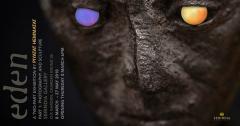นิทรรศการ "หิมพานต์ : Eden"

นิทรรศการ "หิมพานต์ : Eden" ผลงานโดย ปิยทัต เหมทัต (Piyatat Hemmatat) จัดแสดงระหว่างวันที่ 8 มีนาคม - 27 พฤษภาคม 2561 และจะมีพิธีเปิดในวันที่ 8 มีนาคม 2561 เวลา 18.00 น. ณ Serindia Gallery : เซรินเดีย แกเลอรี่
หิมพานต์ โดย ปิยทัต เหมทัต
นิทรรศการนี้ทดลองหาความเป็นไปได้ทางศิลปะ เพื่อมีส่วนร่วมในการโต้เถียงที่เต็มไปด้วยความขัดแย้งทางความคิด โดยมุ่งหวังให้การมีส่วนร่วมเป็นไปอย่างสร้างสรรค์และเกิดประสิทธิผล การโต้เถียงดังกล่าวว่าด้วยการใช้ตัวยาที่ได้จากพืช ไม่ว่าจะเป็นไปเพื่อการบำบัดรักษาหรือเพื่อสันทนาการก็ตาม นิทรรศการ หิมพานต์ เลือกที่จะเล่าเรื่องต่างไปจากเดิม โดยเลี่ยงการแบ่งแยกความคิดสองขั้วที่สนับสนุน-ต่อต้านการใช้พืชที่ออกฤทธิ์ต่อจิตประสาท เพื่อกระตุ้นวิธีคิดและการรับรู้ใหม่ๆ เกี่ยวกับการใช้สารเหล่านี้ ทั้งในทางที่ก่อประโยชน์และในทางที่เกิดโทษ ด้วยการผสมผสานภาพถ่ายจากล้องจุลทรรศน์ และประติมากรรมสำริด ผมตั้งใจที่จะเน้นคุณสมบัติทางสุนทรียภาพของพืชทั้งหลายที่มีสารออกฤทธิ์ที่สามารถส่งผลต่อสมอง และ/หรือปรับเปลี่ยนสภาวะทางจิตของผู้ใช้
การสำรวจเชิงทดลองนี้ซึ่งยังคงดำเนินอยู่ในปัจจุบัน มีจุดเริ่มต้นที่ชุดภาพถ่ายส่วนต่าง ๆ ของต้นกัญชา ซึ่งมีสารออกฤทธิ์ต่อจิตประสาทที่เรียกว่า เตตร้าไฮโดรแคนนาบินอล (Tetrahydrocannabinol หรือ THC) โดยใช้กล้องฟิล์มขนาดกลางที่ใช้เลนส์กล้องจุลทรรศน์จากต้นคริสต์ศตวรรษที่ 20 ผลลัพธ์ที่ได้คือรูปร่างและโครงสร้างที่ชวนฉงนซึ่งสร้าง “สวนอีเดน” หรือ หิมพานต์ ให้ปรากฏขึ้นในปัจจุบันขณะอีกครั้ง ภูมิทัศน์สีสันสดใสตระการตาเป็นดั่งภาพฝันและภาพหลอนที่โลดแล่นมีชีวิต และช่วยให้มองลึกลงไปในธรรมชาติและวัฒนธรรมของพืชเหล่านี้ ที่คนเราทั้งเห็นคุณค่าและสาปแช่ง เนื่องจากคุณสมบัติชีวเคมีบางประการในพืชที่มีอำนาจล่อใจ
ความขัดแย้งระหว่าง “ความดีงาม” และ “ความชั่วร้าย” ที่ดำรงไว้ในผลงาน เป็นส่วนสำคัญของความพยายามที่ผมจะหาตำแหน่งแห่งที่ให้กับพืชเหล่านี้ในระเบียบจักรวาลในปัจจุบัน เพื่อให้บรรลุเป้าหมายดังกล่าว ผมนำรูปเชิงสัญลักษณ์ที่เกี่ยวเนื่องกับ “การตกสวรรค์ของมนุษย์” มารวมกับภาพถ่ายกล้องจุลทรรศน์ของเมล็ด ก้าน ราก และใบของต้นกัญชา และผลิตซ้ำด้วยเทคโนโลยีและเทคนิคการพิมพ์ภาพ โดยอาศัยฝีมือช่าง เครื่องจักรกล และระบบดิจิทัล เพื่อให้ผลลัพธ์ที่เกิดขึ้นเพียงชั่วคราวปรากฏอยู่ถาวร ผลงานในชุดนี้ประกอบไปด้วย ภาพชาร์โคลพรินท์ (charcoal print) แบบคริสต์ศตวรรษที่ 19, ภาพซีพรินท์ (C-print) สมัยใหม่ และภาพจิเคล พรินท์ (giclée print) การถ่ายทอด‘ปุ๊น’ออกมาเป็นภาพมีลักษณะคล้ายกับดวงดาวอย่างที่ได้เดาและคาดการณ์ไว้
ณ ที่ที่มิติจักรวาลและจุลภาครวมกันเป็นหนึ่ง เราจะได้เห็นหนทางนานัปการที่กัญชาและพืชที่มีสรรพคุณคล้ายคลึงกันสามารถท้าทายกฎเกณฑ์และแนวคิดทางกฎหมายและวัฒนธรรม และพ้นจากกรอบข้อบังคับและขอบเขตอันคับแคบที่จำกัดการเข้าถึงและการบริโภคพืชเหล่านี้โดยการโอบล้อมด้วยข้อบังคับและขอบเขตดังกล่าวไว้ อย่างเช่นงูที่เลื้อยล้อมผลแอปเปิ้ล ผลงานนี้ใช้เวลาในการสร้างกว่า 3 ปี ตั้งแต่ 2558 เป็นต้นมา
-------------
EDEN, the latest exhibition by artist and photographer Piyatat Hemmatat, engages the viewers in the creative visualisation of plant-derived narcotics, offering an alternative narrative to stimulate fresh ways of thinking and perceiving about substance use and abuse. By combining microscopic photography with bronze sculpture, Piyatat Hemmatat accentuates the aesthetic properties of a number of plants that can affect the brain and/or alter the state of mind of the user.
In Part 1 of EDEN at Serindia Gallery, Piyatat explores the subject with a series of microscopic images of parts of the Cannabis plant that contains the psychoactive substance Tetrahydrocannabinol (THC). Shot through the lens of an early twentieth century microscope with a medium format film camera, we see mysterious configurations that recreate the mythological “Garden of Eden” in the here and now. The phantasmagorical or psychedelic landscapes that come alive in these pictures provide a deeper look into the nature and culture of plants appreciated and cursed for their specific biochemical properties that have allure.
Retaining the friction between “good” and “evil” has been essential in my attempt to place these plants in a cosmological order of our time. To that end Piyatat combined the symbolic figures associated with “the fall of man” with microscopic images of the seed, stem, root, and leaf of this psychoactive plant, and reproduced with artisanal, mechanical, and digital printing technology and techniques to create a lasting ephemeral effect. They comprise 19th century chacoal print, modern chromogenic print, and giclée print. These photographic renderings of “pot”, predictably and expectedly, have come out in a planetary manner. Where the microcosmic and cosmic dimension become one, we catch a glimpse of the manifold ways by which this, and other such plants defy legal and cultural precepts and concepts and escape narrowly defined rules and boundaries that restrict their availability and consumption by encircling them; hence the serpent and the apple.
